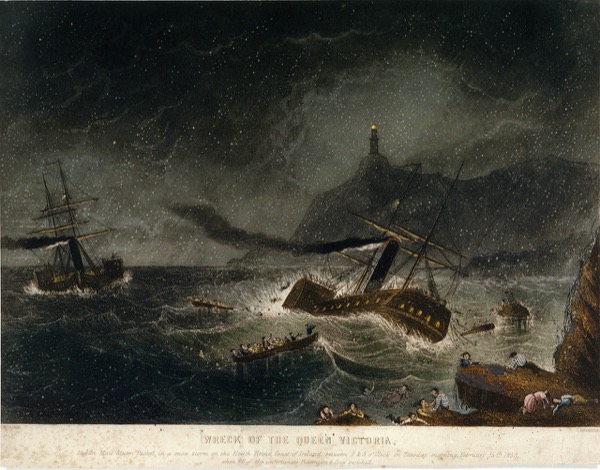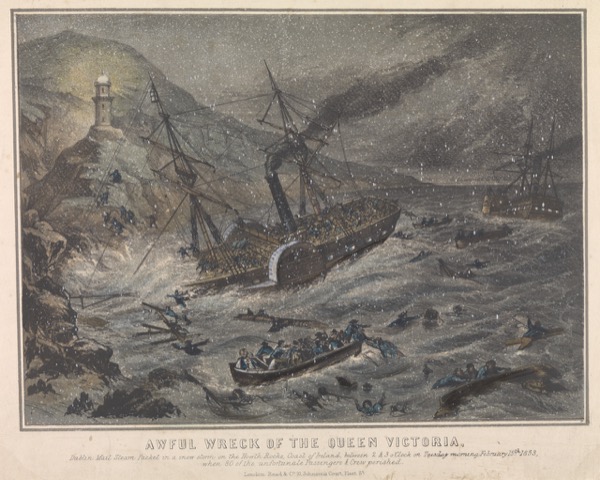

Queen Victoria
Wooden paddle steamer launched August 1837 Wilson Liverpool, 337 tons register.
Side lever engines 280 hp by Mather, Dixon & Co., Liverpool
[Connell of Belfast also launched a PS Queen
Victoria in July 1837 - later known as Victoria - for the Down & Liverpool Co. ]
Owned City of Dublin Steam packet company, registered Dublin.
Captain Church and 24 crew with 87 passengers (112 total; 59 lost)
Voyage Liverpool to Dublin
Wrecked Howth Head 15 February 1853 near Baily Lighthouse.
Location 53°21.602' N, 6°3.061' W in 18m depth.
More history.
It was a fine February day (14th) in 1853 when the paddle steamer Queen Victoria of the City of Dublin Steam packet Company, left Liverpool at 3pm for Dublin. On board were 87 passengers, 24 crew and one stewardess. Approaching the mouth of Dublin Bay in the early hours of February 15th, the ship was enveloped in a snowstorm and thick fog.
A course had been set using the Kish light and the Baily light at Howth. However, visibility became so poor that, when the steamer was some 20 yards from the Baily cliffs, and moving at nine knots, the lookout let out a wild roar. It was too late - the bow was already on the rocks. Panic ensued, and about eight people managed to scramble ashore. Ship's master Capt Church ordered the engines to be put into reverse, to try and run the vessel up on the North Bull, which resulted in the ship getting into deeper water where she was found to be leaking badly. A fatal decision: the ship began to sink.
Some passengers clambered into a starboard-quarter lifeboat. It snapped from its davits due to the overload - dropping like a stone into the sea, drowning all on board. The port lifeboat was found to be leaking, but a young boy is said to have used his finger to plug the gap. That lifeboat managed to reach shore, with the brave oarsmen returning to save another five people clinging to the ship's masts. Another 40 people were picked up by the crew of the steamer Roscommon (Captain Browne, from the same company) and landed at Dun Laoghaire. Accounts vary on the final toll of deaths, believed to be around 80 lives lost [but see Report later], including Capt Church.
Illustrations of the wreck of the Queen Victoria:


The official government inquiry found Church to have been negligent, but it
also excoriated the Dublin Port Authority for the inefficiency of its
lighthouse service - a finding which contributed to the establishment of the
Commissioners of Irish Lights 14 years later.
Early (helmet) dive: William Campbell came across in an attempt to raise the Queen
Victoria wrecked at Howth.
Attempts to raise the wreck were unsuccessful and she was salvaged
in situ.
In 1983, divers with Marlin Sub Aqua Club found the Queen Victoria south of
Baily, and its figurehead was given to the National Maritime Museum in Dun
Laoghaire.
Report
Return to Early SS wrecks.
More detail of his salvage dive: From: Freeman's Journal, Tuesday 15 March 1853
THE QUEEN VICTORIA. - TO THE EDITOR OF THE FREEMAN.
SIR - I noticed a paragraph in
your paper of the 7th March, stating the wonderful things I saw on my
descent into the cabin of the wreck of the Queen Victoria steamer. I
beg leave to state that the correspondent of the Morning Post either
must have fancied the thing himself, or was most grossly misinformed of
the facts connected with the matter, as in place of my seeing any
persons in the cabin with glasses, charts etc., before them, it was with
the utmost difficulty that I could ascertain my whereabouts on my coming
in contact with the deck, the tide at the time running strong to the
north-east, which it continues to do for more than nine hours out of
twelve. I went down by a rope with a grapnel attached, which was hooked
into a part of the machinery. As soon as I let go, on my feet touching
the deck, the tide carried me to the vessel's side, at the after part of
the paddle-box, and the funnel, which fell over previous, lay at
an angle of about 45°, one end on the sands, or bottom and the other
on the rail, or covering board, of the vessel, the water being, as it in
fact always is, quite thick or muddy in the race of the tide off Howth.
I could not see anything; it was by feeling, I could ascertain that I
was introduced into the funnel, down which I was about being carried. I
caught hold of the edge of it, in my trying to get hold of something to
steady myself. The water is about 62 feet deep at low tide. I could
not do any good in the way of an inspection, finding the shrouds, that
held the funnel, were already broken (as the chief business that brought
me there was to get it clear of the ship's side to facilitate the
passing of the chains). I could not see anything, not even my fingers
placed against the glass of my helmet; it was by feeling, I found I was
first on the engine machinery, and then at the funnel's mouth. I never
by any means, directly or indirectly gave such a report as is stated in
the paper of seeing the passengers in the cabin. I can prove there can
be none there, as I was an eye witness to the deck, skylights, funnel of
the cabin stove, sundry articles of furniture, the framework, doors etc.,
of every description, pillows, cushions, and parts of cargo, coming
floating up to the surface. I aided in the recovery of some of these
things myself, so that it is quite evident there was not a possibility
of a human being remaining on board. Even had the water been clear and
that I had the opportunity of seeing the captain, I candidly say I would
not know the unfortunate gentleman, as in life I, to my knowledge, never
saw him. I am very much annoyed and fretted at the way I am stopped in
the streets by the people asking if I saw all that is stated in the
paper of Monday 7th March. I hope, Sir, you will be so kind as to give
insertion to this paragraph, as it will be the means of quieting a great
many anxious persons. I remain, Sir, your most obedient servant,
WILLIAM CAMPBELL. 10th March, 1853.
Report of Inquiry into wreck
Collision of Prince in 1846 in
similar location